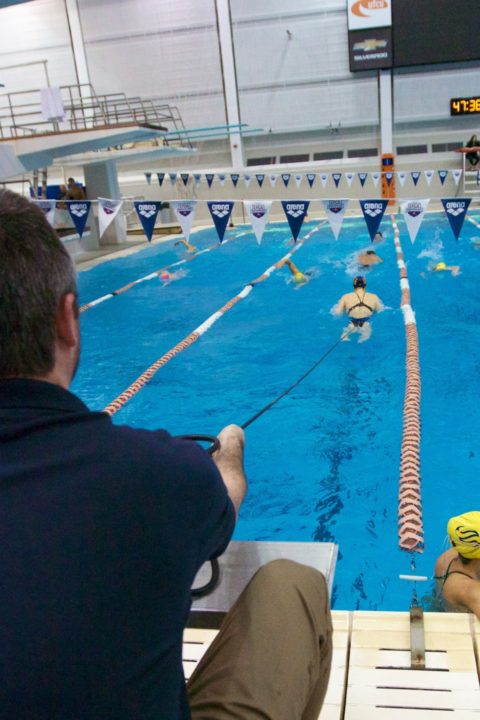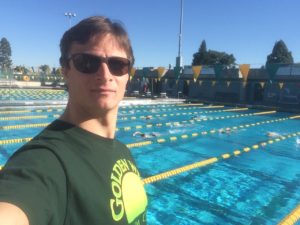Courtesy: Danylo Proskura
In the world of swimming, there is a discussion about the effectiveness of different training methods such as aerobic-based training and high-intensity training such as capacity versus utilization. All these methods have proven effectiveness, but there is one common denominator that cannot be denied: injury. Injuries due to overuse are a common source of pain in competitive swimmers.
In 1974, Kennedy and Hawkins used the term Swimmer’s Shoulder to describe the problem of shoulder pain in swimmers. With a continuing analysis of shoulder pain, it became evident that the cause may be multifactorial, including overuse and shoulder muscles fatigue, laxity and instability, and biomechanics of the swimming stroke. McMaster and Troup surveyed competitive swimmers and identified that 47 percent of 13-14-year-olds, 66 percent of 15-16 year-olds, and 73 percent of elite college swimmers experienced shoulder pain associated with swimming.
In competitive swimming, a swimmer undergoes continuous revolutions. Regardless of the stroke and the level of technical skill, this continuous movement puts stress on the shoulders and potentially leads to injury from repetitions. Young athletes are at risk for chronic injuries related to overuse.
Like most swimming pathology, overuse is the primary factor in causing knee pain and injuries. This is related to the whip kick that performed at high peak angular velocities due to the extension and flexion, external rotation, and the hip abduction and adduction movements. Repetitive hydrodynamic forces result in cumulative stresses that increase the risk of soft tissue injuries. The spine is also a recognized site predisposed to injury in a swimmer. It is associated with hyperextension of the lumbar spine due to the undulating motion.
These data demonstrate the inadequate development of strength in athletes in relation to the loads that they endure.
From a young age, coaches begin to introduce workouts with long repetitive training or high-intensity interval training. This could lead to a rapid increase in results, although the versatile development of necessary motor skills for the child’s growth and development is pushed to the background.
Parents and young swimmers look at performance as the primary evaluation of progress. To make kids faster is a requirement from the youngest age to keep them on the team, and to move up groups. The financial aspect is very important too because if you a coach is not going to make a young swimmer faster, then there is another team that presumably will. Because of that, every coach is under huge performance pressure. By the time young swimmers mature they experience all sorts of training methods and sets with very little understanding of the mechanics and patterns of swimming.
YOU HAVE TO BE PATIENT WHEN YOU ARE COACHING YOUNG SWIMMERS.
Young swimmers will improve their performance simply because they are growing and building more confidence in the water. They do not need to be trained as miniature adults.
Advancing a young swimmer is very important by teaching skills and implementing a long term athlete development program. Coaching progressively and appropriately to the age level of an athlete is the difference between training and teaching. The total hours of organized sports per week should be less than or equal to a child’s age in years.
Both outside the water with dry-land programs and inside the water workouts with lactic-stress based and long repetitive sessions, you may favor tiredness, laxity, and poor accuracy in technique with young swimmers. This should be taking into consideration when developing a training plan.
Building a solid skill requires a process: starting to focus on some fundamental technical points on short divided sets and holding on to the skills during sets which are going to be more extensive or intensive. For example, breath technique, streamlining or kicking off the wall, body balance, and recovery.
“Skill perfection must always come ahead of skill acquisition” – Bill Sweetenham
In young swimmers, changes to the body structure and composition require optimal motor learning and kinesthetic awareness. Multiplanar dryland and swimming drills are valuable in developing a swimmer because a variety of movements provide better body awareness. A sequence of actions from small to big and from easy to complex could be adapted to the demands of the growing body.
The goal of teaching is to provide age swimmers with a variety of tools so they can develop their perfect stroke. As well as building a solid foundation of strength and mobility, prepare the musculoskeletal system and other body systems for the upcoming extensive physical stress.
EVALUATION AND PREVENTION
Training of core muscles (strengthening, stabilization, and mobility) is an essential component of any injury prevention program. Abdominal and scapular muscle strengthening should be emphasized in the dry-land training program. It helps to create powerful and efficient strokes and kicks without excess energy dispersion, contributing to proper body rotation and undulations.
A training program based on preventative work incorporates periodically evaluating the position of the humeral head as well as mobility tests of the shoulders. If the structure is hypertrophic and stiff, work on the myofascial release such by foam rolling and doing shoulder mobility exercises. If the structure is hypotrophic, strengthen it using specific dryland and in-water exercises. Focus on emphasizing scapular stability and rotator cuff strength as well as increasing front side flexibility and posterior joint mobility. Correct muscular imbalances by increasing back side strength and improving posture.
“Every training session is crucial.” – Fabrice Pellerin
Maturation and strength foundation will prepare athletes to be ready to train and to see results from the training. Well-developed swimmers will adapt better to new stresses caused by increased volume, intensity, and hours of training. A 20 years-old athlete will benefit from 20 hours a week of high volume or intensity, whereas a 12 years-old athlete will gain more from skill acquisitions and body development.
An extensive program of strengthening, and functional development through the full range of motion, in addition to the education of proper stroke mechanics, warm-up and stretching techniques, and dry-land strength training, should form the foundation of an elite swimmer’s training regimen.
Coaches have a critical responsibility to not only develop swimmers but to protect their development. All coaches must have a vision and a foundational program that provides complete training without it coaches will be failing their swimmers as well as themselves.
References
1. Kennedy JC, Hawkins RJ. Swimmers shoulder. Physician Sports Med. 1974;2(4):34-38
2. McMaster W.C., Troup, J.: A survey of interfering shoulder pain in United States competitive swimming. Am J Sports Med 1993;2(1):67-70
3. Wanivenhaus F, Fox AJ, Chaudhury S, Rodeo SA. Epidemiology of injuries and prevention strategies in competitive swimmers. Sports Health. 2012;4(3):246-251. doi:10.1177/1941738112442132
ABOUT DANYLO PROSKURA
Danylo is an associate head swim coach at the Golden West Swim Club in Huntington Beach, California. He began his coaching career in 2004 with the Aquatic Club Motor Sich in Zaporizhzhya, Ukraine. Additionally, in 2013 Danylo joined the international Energy Standard Swim Club. After working with Olympic athletes in Ukraine in 2015, he moved to California and started to work with the Piranha Swim Team, where he helped develop a program in Loma Linda.


Interested to hear your thoughts on injury prevention and long term athlete development programs.